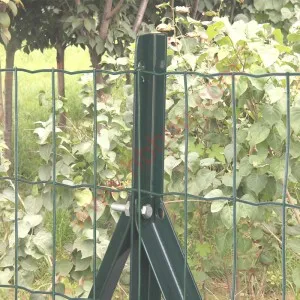Setting Metal Fence Posts Without Concrete A Comprehensive Guide
When it comes to installing a metal fence, many homeowners often consider using concrete for securing the fence posts. However, setting metal fence posts without concrete is an equally effective method that can save time, reduce costs, and provide a more flexible solution, particularly in areas with tricky soil conditions or where future adjustments may be necessary. This article provides a comprehensive guide on how to properly set metal fence posts without relying on concrete.
Choosing the Right Location
Before installing your metal fence posts, start by identifying the location and layout of your fence. Mark the positions for your fence posts using stakes and string. Ensure that your layout conforms to any local regulations or property lines. Proper placement is crucial, as it determines the fence's stability and aesthetics.
Selecting the Proper Materials
For setting metal fence posts without concrete, you'll need
1. Metal Fence Posts Typically galvanized steel or aluminum for durability and resistance to rust. 2. Gravel or Crushed Stone These will provide drainage and stability. 3. Post Level or Plumb Bob To ensure your posts are vertical. 4. Tamping Tool For compacting the soil around the posts. 5. Soil or Landscaping Fabric To prevent weeds from growing around the base of your posts.
The Installation Process
1. Dig Post Holes Using a post hole digger or auger, create holes that are about 3 times the width of your posts and 2 to 3 feet deep, depending on the size of the fence and local frost lines. This depth will ensure stability.
2. Add Gravel to the Bottom Place around 6 inches of gravel or crushed stone at the bottom of each hole. This will promote drainage and prevent water from pooling around the base of the post, which can lead to rust or instability.
setting metal fence posts without concrete

3. Insert the Metal Post Position your metal post in the center of the hole, ensuring it's straight. Use your post level to check that it is plumb.
4. Backfill with Gravel Gradually fill the hole with additional gravel, packing it tightly around the post as you go. This method provides excellent drainage while ensuring the post remains stable.
5. Compact the Soil Use your tamping tool to compact the gravel tightly. This will help secure the post, making it less likely to shift over time. It is essential to compact it thoroughly to enhance stability.
6. Fill in the Rest of the Hole After compacting, you can fill in any remaining space with soil or gravel, ensuring that the area around the holes is appropriately leveled.
Additional Tips for Long-Term Stability
- Select Quality Posts Invest in high-quality metal posts to ensure durability and resistance to the elements. - Consider Adding Supports For taller fences or those in windy areas, consider adding diagonal supports or braces during installation for added strength.
- Regular Maintenance Inspect the fence periodically for any signs of movement or damage, especially after storms or heavy winds. Early detection will allow you to rectify issues before they become serious.
Conclusion
Setting metal fence posts without concrete is a viable option that offers flexibility and ease of installation. By carefully preparing the site, utilizing gravel for drainage, and ensuring proper post alignment, you can create a sturdy and lasting fence that enhances the beauty and security of your property. With the right approach, your metal fence can stand strong for years to come, giving you peace of mind and enhancing your outdoor space.
















